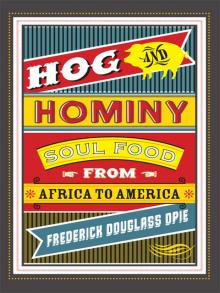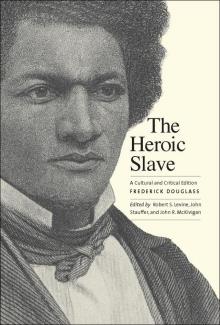- Home
- Frederick Douglass
Hog and Hominy: Soul Food From Africa to America Page 6
Hog and Hominy: Soul Food From Africa to America Read online
Page 6
Religious workers regularly organized weeklong revivals that were often interracial, communitywide events. Fredrika Bremer described a camp meeting revival she observed during a visit to Macon, Georgia, in May 1850. “After supper I went to look around, and was astonished by a spectacle that I shall never forget. . . . An immense crowd was assembled, certainly from three to four thousand persons. They sang hymns—superb choir! Strongest of all was the singing of the black portion of the assembly, as they were three times as many as the whites.”13
At sunrise, Bremer woke to the delightful sound of African Americans singing hymns and the delicious smell of frying ham and eggs, simmering red-eye gravy, steaming rice or grits, and baking buttermilk biscuits and corn bread. “People were cooking and having breakfast by the fires, and a crowd was already” gathering and filling the benches under the tabernacle for the seven o’clock morning worship service and the eleven o’clock sermon that would follow. “After the service came the dinner hour, when I visited several tents in the black camp, and saw tables covered with all kinds of meat, puddings, and tarts; there seemed to be a regular superfluity of food and drink.”14 Bremer’s description of this Georgia camp meeting is reminiscent of travelers’ descriptions of singing and feasting during West African religious gatherings, discussed earlier.
In some parts of the South before emancipation, the Church was the only institution in which whites permitted African American southerners to maintain their own peculiar way of satisfying their souls and bodies with spiritual and natural food. The autonomy of African American religious churches in the South naturally increased with the abolition of slavery. Moreover, the use of churches for community events drastically increased. Freedom for many African American southerners meant more time for church events like revivals and allowed for the addition of new events to a church’s yearly activity calendar, such as Emancipation Day celebrations. But descriptions of Christmas feasts indicate that it was the most lavish of the yearly food-accompanying celebrations.
“Sundays and revival meetings,” writes a historian of African American religion, “were not the only respites from work anticipated by the slaves. Christmas was the most festive holiday of all.”15 Masters generally granted slaves the week of Christmas off and gave those who wished it permission to visit nearby plantations where friends and relatives lived. They also furnished slaves with additional bacon and cornmeal rations, as well as flour and fruit for making biscuits, preserves, tarts, and pies.16 Additional rations distributed for Christmas and time off from the fields allowed women to cook delicious dishes like ribs, hams, chops, chitlins, stews, soups, and sauces for their families and friends.17
Soul—Africanisms, spirituality, southern style, pride, love, care, and joyous hard work—cannot be understood without taking into consideration southern American religious rituals and oral traditions. During slavery, members of plantation communities brought the best of their first fruits and dishes to share with friends, family, and visitors. In the South, the most important religious celebrations coincided with the end of the harvest, when communities had an abundance of food and leisure time.
During slavery, foods cooked on Sundays and special occasions played an important role in southern African American religious traditions. Most slaves considered Sunday special because they could visit kinfolk on different plantations and make special meals that expressed their love for family and friends. Oral traditions allowed them to pass down instructions to the next generation on the intricate preparation of foods eaten on religious days: fried chicken, barbecued beef and pork, biscuits, pies, and cakes.
SHARED CULINARY TRADITIONS BETWEEN AFRICANS AND EUROPEANS
Enslaved Africans did not develop their traditions within a vacuum. In some instances, whites, particularly white children, had intimate relations with blacks. Through close interaction, whites integrated many African religious and language elements. “Southern whites,” argues historian John W. Blassingame, “not only adapted their language and religion to that of the slaves but also adapted agricultural practices, sexual attitudes, rhythm of life, architecture, food and social relations to African practices.”18 As masters adopted African foodways and slaves adopted the holidays and special occasions of their owners, black and white cultures in the South became more homogeneous.
By the nineteenth century, African Americans had clearly established a penchant for corn, rice, greens, pork and pork-seasoned foods, and fried foods. Over time, the planter class took great delight in the dishes of their slaves, such as chitlins; turnip greens, collards, and kale simmered with smoked pork parts; roasted yams; gumbos; hopping John, corn bread, crackling bread, and cobblers; and various preparations of wild game and fish.19 Masters, claimed historian Eugene D. Genovese, “imbibed much of their slaves’ culture and sensibility while imparting to their slaves much of their own. . . . Slavery, especially in its plantation setting and in its paternalistic aspect, made white and black southerners one people while making them two.”20 Accounts of food eaten by white planters support this assertion. For instance, on the tobacco plantation in St. Petersburg, Virginia, that Olmsted visited, enslaved Africans covered the big-house table with platters of hot corn bread, sweet potatoes roasted in ashes, and fried eggs. More enslaved waiters arrived from the cookhouse bearing plates of cold roast pork and roast turkey, fried chicken, and an opossum cooked in such a way that, according to Olmsted, it “somewhat resembled baked suckling-pig.”21 Traditionally opossum was one of several victuals that slaves obtained on their own to supplement their woefully inadequate slave rations. Former Maryland slave Frederick Douglass described how, when given free time, the “industrious ones of our number would employ themselves in. . . hunting opossums, hares, and coons.”22 Here, however, it is served by slaves to whites. Similarly, yams before the nineteenth century were part of what planters distributed as slave rations. But by the mid nineteenth century planters in the South no longer considered sweet potatoes and yams the food of slaves. At the Virginia tobacco plantation, Olmsted recalled, “There was no other bread, and but one vegetable served—sweet potato, roasted in ashes, and this, I thought, was the best sweet potato, also, I ever had eaten.”23
The great complaint of the slaves was the monotony of their assigned diet of largely salt pork and cornmeal. In addition to raising chicken and pigs and hunting small game, they also responded by growing beans and greens. Through their own efforts they created heavily seasoned preparations of chitlins, collard greens, okra, and turnip greens and dishes such as hopping John. Genovese holds that enslaved Africans were not alone in enjoying these classic soul food dishes. Both poor whites and those in the planter class enjoyed them too. Blacks created the dishes, prepared them for their masters, and, in Genovese’s words, “contributed more to the diet of the poorer whites than the poorer whites ever had the chance to contribute to theirs.”24 Speaking of poor whites in rural South Carolina, Olmsted observed, “Their chief sustenance is a porridge of cow-peas, and the greatest luxury with which they are acquainted is a stew of bacon and peas, with red pepper, which they call ‘Hopping John.’” Poor whites, in Olmsted’s estimation, seldom had any meat, he said, “except they steal hogs which belong to the planters, or their negroes, and their chief diet is rice and milk.”25 Food scholars generally recognize rice as a staple as an African introduction to the Americas. In Brazil, Feijoada, the staple of most slaves, was made from black beans, jerked beef, and rice slaves received as rations. They enhanced the rations used to make feijoada by adding spices and discarded animal parts like tongues, ears, feet, and tails from slaughtered farm animals. They also added caruru (cooking greens) and large amounts of pepper.26
Afro-Cuban cooks viewed a huge dish of cooked rice as an essential accompaniment to any meal they served. Without rice, Cubans of all complexions and classes regarded meat and other dishes at the table with indifference.27 A similar attitude about the necessity of rice at every meal developed among black and whites in low-country South Carolina and
Georgia.
Olmsted describes another example of Africans and Europeans sharing a culinary tradition among a steamship crew in Mobil, Alabama. “The crew of the boat. . . was composed partly of Irishmen, and partly of negroes; the latter were slaves, and were hired of their owners at $40 a month—the same wages paid to the Irishmen.”28 Olmsted observed, “so far as convenient” the ships captain kept the blacks “at work separate from the white hands; they were also messed separately.” As members of the same working class onboard the ship, the black and white crewmen ate the same food. “The food, which was given to them in tubs, from the kitchen, was various and abundant, consisting of bean porridge, bacon, corn bread, ship’s biscuit, potatoes, duff (pudding), and gravy.”29
In Louisiana, working-class blacks and white shared similar culinary histories as consumers of foods purchased on the streets of New Orleans. In the Crescent City, African Americans wearing bright handkerchiefs as head wraps carried baskets and basins containing fried chicken and fish dinners that they sold to dock workers. Moreover, New Orleans residents sold out of their homes food typical of African American cuisine. “Those fresh from the gombo [sic] soup, and the ham, and the punch and julep, rushing back again. . . . I tremble to think of. . . punches, and nogs, and soups, and plates of fish, and game, and beef and loaves of bread, that I have seen appear from side doors and vanish” for a dime each.30 A similar commercial and culinary culture developed in nineteenth-century Brazil. In Rio, African Brazilian street vendors gained fame for the sale of a fish meal called batatas doces, described as sardines fried in dendê oil and broiled shrimp served with spinach, hearts of palm, and sweet potatoes.31
By the eve of the Civil War, whites in the South of all classes had accepted black cookery and made it part of their everyday cuisine. Nineteenth-century accounts tell us that whites who lived and worked in close proximity to slaves typically ate the same cheap, delicious, and filling dishes that slaves developed to temper the monotony of their food rations.32 The same development occurred in Brazil, where black majorities shaped the cuisine of whites. By the mid-nineteenth century, feijoada was a staple of Brazilians of all classes. Travelers Louis and Elizabeth Agassiz noted that there was “no house so rich as to exclude” feijoada from the table. Depending on the region, the same could be said for corn bread, rice, and salt pork in the United States.33 In short, whites and blacks influenced each others’ foodways, if in different ways. Whites provided the material culture and adopted the culinary creativity of their African American cooks, coworkers, and neighbors. By the nineteenth century, the majority of the poor white population in the South enjoyed all parts of the hog, corn bread, greens, sweet potato pie, candied yams, and black eyed peas and rice. On the eve of the Civil War, poor white and black southerners were eating the same diet, based on greens, rice or corn, and skimpy amounts of meat.34
THE CIVIL WAR AND RECONSTRUCTION
During the Civil War (1861–1865) both Confederate and Union soldiers very often depended on African American cooks on the battlefield. Northern army officers put free-born blacks and runaways into segregated regiments, paid them less than white soldiers, and fed them inferior food. Union officers subjected African Americans to corporal punishment evocative of their enslaved experience and assigned them menial duties like cooking rather than combat. In a March 1863 letter from Washington, D.C., for example, H.W. Halleck, apparently a high-ranking member of the Northern strategic command, suggested ways to organize black troops in the field along the Mississippi River. He writes, following the example of one General Banks near New Orleans, that freedmen “can be used to hold points on the Mississippi during the sickly [malaria] season” and they “certainly can be used with advantage as laborers, teamsters, cooks, &c.”35
FIGURE 3.1“Sweet Potatoe Planting—James Hopkinson’s Plantation, Edisto Island, S.C, April 8, 1862.” Photographs and Prints Division, Schomburg Center for Research in Black Culture, New York Public Library, Astor, Lenox, and Tilden Foundations.
Southern armies also used the labor of slaves and free blacks for menial tasks like cooking. President Jefferson Davis ordered planters to turn over one out of every ten slaves for voluntary war labor. These “Negro servants,” as the Confederates called them, cleaned and cooked whatever soldiers caught, shot, and gathered as food.36
Pork and corn bread, sweet potatoes, and sweetmeats represented the most requested foods among Southern troops both black and white. In the Union army, African American troops requested additional corn bread and pork as rations. When commissary officials complied, southern-born white soldiers celebrated the change, while “their Northern-born comrades, accustomed to beef and wheat bread, complained bitterly.”37
For most of the war, the South had no trouble producing food for its soldiers, though by its end, in 1865, Northern forces had advanced deep into the black belt, and pitched battles and foraging soldiers had ruined productive fields and reduced domesticated hogs and wild game almost to extinction.38 Getting provisions to the field, however, represented the Confederate command’s greatest shortcoming. There was a shortage of salt and other preservatives to keep the food and a shortage of money and transportation to ship it. Confederate forces were constantly short of cans, boxes, and barrels for shipping food to the battlefields. With the lack of regular food shipments, soldiers survived on handouts from civilians, rations taken from the remains of dead Union soldiers, and sustenance found foraging in the woods and raiding civilian homes and farms. Soldiers fighting along the Atlantic Coast also fished.
When they did obtain food, soldiers then had to confront a shortage of cooking utensils.39 Some made them from the bottom halves of captured canteens and cooked meat on the points of sharp sticks. Others mixed meal and flour in turtle shells, calabashes, shirttails, and other makeshift containers. By the end of the war, many white soldiers who previously had no cooking experience became experts at creating what became southern delicacies after the war: huckleberry pie, roast pork, turkey, and opossum. For black southerners, preparing such dishes was nothing new.
FIGURE 3.2 African American army cook at work in City Point, Virginia. Library of Congress, Prints and Photographs Division, LC-B811-2597.
EDUCATION, CLASS, AND THE AFRICAN AMERICAN DIET IN THE NEW SOUTH DURING RECONSTRUCTION
Various forms of tenant farming replaced plantation slavery. Sharecropping and tenant farming did very little to improve the nutritional conditions of the freedmen. Most southerners continued hearth-cooking practices and existed largely on simple diets reminiscent of the antebellum period. As one historian concluded, the “three M’s, that is, meat (meaning salt pork), meal, and molasses, continued as the core diet.”40 Samuel H. Lockett, who traveled through Louisiana in 1871, argued that the people of the South needed to reform their eating habits:
The greatest drawback to the people in the pine woods [referring to the South in general] is the manner in which they live, I mean the food they eat. Three times a day, for nearly 365 days of the year, their simple meal is coarse corn bread and fried bacon. At dinner there will be added perhaps “collards” or some other coarse vegetable. Even when they have fresh meat or venison, which they can obtain whenever they wish, it is always fried and comes to the table swimming in a sea of clear, melted lard. Chickens, eggs, milk and butter, all kinds of vegetables and fruit they could have, but have not. I really believe that the best missionary to send among them would be a disciple of A. Soyer, the great French cook. Let him preach “good health by good living,” distribute throughout the Piney Woods and, in fact, throughout the rural districts of much of our southern country, dime cookery-books, and sell all the frying pans, and the mental, moral, and physical condition of the population would soon be immensely improved.41
Yet, Many African American sharecroppers and tenant farmers almost starved to death because they moved too often to be able to develop the type of gardens they had used to supplement their diets during the antebellum period. As a result, they ate very unbalanced meal
s full of saturated fats. In addition, beginning in the late 1870s, they began purchasing highly processed food staples. For example, groups of poor southerners increasingly turned to merchants for cornmeal and white flour. New high-efficiency roller mills increased the production speed of these staples, but they also stripped the processed grains of their healthy nutrients and fiber.
In the late 1880s, the U.S. Department of Agriculture—in collaboration with two historically black colleges and universities (HBCUs), Tuskegee Institute and Hampton Institute—performed dietary studies of African American farmers in the vicinities of Tuskegee in Macon County, Alabama, and Hampton in Franklin County, Virginia. These studies examined over a dozen families. Investigators visited each house for two weeks, “taking specimens for analysis, notes being made at the same time regarding the people, their dwellings, farm work [agricultural practices], habits, and the like.”42 These studies provide details about the eating traditions of southern farmers in the late nineteenth century.
FIGURE 3.3 Old African American couple eating at a table by a fireplace in rural Virginia. Library of Congress, Prints and Photographs Division, LC-USZ62-61017.

 Narrative of the Life of Frederick Douglass: An American Slave
Narrative of the Life of Frederick Douglass: An American Slave My Bondage and My Freedom
My Bondage and My Freedom Two Slave Rebellions at Sea
Two Slave Rebellions at Sea The Color Line in America
The Color Line in America The Negro Exodus from the Gulf States
The Negro Exodus from the Gulf States Hog and Hominy: Soul Food From Africa to America
Hog and Hominy: Soul Food From Africa to America Narrative of the Life of Frederick Douglass
Narrative of the Life of Frederick Douglass![An Appeal to Congress for Impartial Suffrage [a machine-readable transcription] Read online](http://i1.bookreadfree.com/i/03/23/an_appeal_to_congress_for_impartial_suffrage_a_machine-readable_transcription_preview.jpg) An Appeal to Congress for Impartial Suffrage [a machine-readable transcription]
An Appeal to Congress for Impartial Suffrage [a machine-readable transcription] The Color Line
The Color Line My Bondage and My Freedom (Penguin Classics)
My Bondage and My Freedom (Penguin Classics) The Heroic Slave
The Heroic Slave